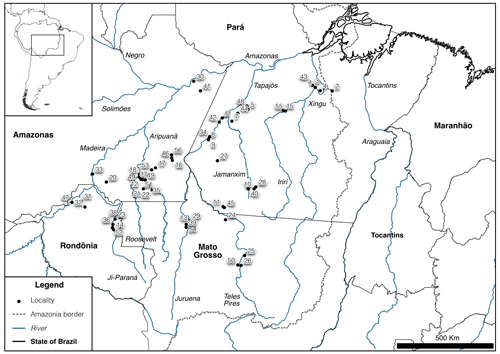the Creative Commons Attribution 4.0 License.
the Creative Commons Attribution 4.0 License.
A dataset of new occurrence records of primates from the arc of deforestation, Brazil
Gustavo Rodrigues Canale
Fabiano Rodrigues de Melo
Raimundo Rodrigues da Silva
Ivan Batista da Silva
Raony Macedo de Alencar
Luciano Ferreira da Silva
Leandro Jerusalinsky
Renata Bocorny de Azevedo
Eduardo Marques Santos Júnior
Italo Mourthé
Emil José Hernández Ruz
José de Sousa e Silva-Jr.
Christian Roos
Izeni Pires Farias
Tomas Hrbek
The so-called arc of deforestation is a major agricultural and industrial frontier in southern Amazonia and northern Cerrado of Brazil. As arboreal mammals, the primates in this region are therefore threatened by forest loss and fragmentation. At the same time, knowledge about the taxonomic diversity and distribution ranges of these taxa is incomplete, which might hamper efficient conservation measurements. New species have been recently discovered in this region, and their ranges remain imprecise because only a few occurrence records are available for each species. Here we present 192 new records of 22 species and subspecies of Alouatta, Aotus, Ateles, Cebus, Chiropotes, Lagothrix, Leontocebus, Pithecia, Plecturocebus, Saimiri, and Sapajus, collected in 56 different localities during 10 field expeditions across the arc of deforestation between 2015 and 2018. Based on these new records, we extend the ranges of Alouatta puruensis, Ateles chamek, and Saimiri collinsi; identify potential hybridization zones between A. puruensis and A. discolor, and between At. chamek and At. marginatus; redefine the range of Plecturocebus moloch; and clarify the ranges of P. baptista and P. hoffmannsi. Moreover, these results and the dataset are valuable for further research on, for example, species distribution and habitat use modeling, for assessing species extinction risks, and for supporting efforts for the conservation of species increasingly threatened on a global deforestation frontier.
- Article
(6585 KB) - Full-text XML
-
Supplement
(410 KB) - BibTeX
- EndNote
The arc of deforestation is a major agricultural and industrial frontier moving north through southern Amazonia and the northern Cerrado (tropical savanna) of Brazil across the southern portions of the states of Pará and Amazonas, in Rondônia, and in the north of the state of Mato Grosso (Fearnside et al., 2009; Silva Junior et al., 2019). The arc of deforestation accounts for approximately half of the global forest conversion into anthropogenic landscapes between 1990 and 2015 (FAO, 2016). This is a direct consequence of the implementation of the BR-230 (Transamazônica) and BR-163 (Cuiabá-Santarém) roads in the early 1970s, which prompted an exponential and disorderly invasion of people from southern and southeastern Brazil motivated by land tenure opportunities and the lack of enforcement of environmental laws for the production of beef, soy bean, and corn (Laurance et al., 2002; Kirby et al., 2006; Fearnside, 2017).
The arc of deforestation still harbors a rich but little-known diversity of primates. Fifty-two primate species are known to occur in this region, including three described recently: Mico munduruku Costa-Araújo, Farias, and Hrbek, 2019 (Costa-Araújo et al., 2019); Mico schneideri Costa-Araújo, Silva-Jr., Boubli, Rossi, Hrbek, and Farias, 2021 (Costa-Araújo et al., 2021); and Plecturocebus grovesi Boubli, Byrne, M. N. F. Silva, Silva-Jr., Costa-Araújo, Bertuol, Gonçalves, Melo, Rylands, Mittermeier, F. E. Silva, Nash, Canale, Alencar, Rossi, Carneiro, Sampaio, Farias, Schneider, and Hrbek, 2019 (Boubli et al., 2019). These primates are directly and negatively affected by the degradation, fragmentation, and loss of habitat. The conservation status of M. munduruku, M. schneideri, P. grovesi (Boubli et al., 2020; Costa-Araújo et al., 2020, 2022a), and others, such as Ateles marginatus, Cebus kaapori, Chiropotes satanas, Mico marcai, and Plecturocebus vieirai, is rapidly escalating to threatened as assessed on the IUCN Red List of Threatened Species (Silva et al., 2020; Fialho et al., 2021; Port-Carvalho et al., 2021; Ravetta et al., 2021; Costa-Araújo et al., 2022b, c). In 2022, P. grovesi was listed as one of the world's 25 Most Endangered Primates (Boubli et al., 2022).
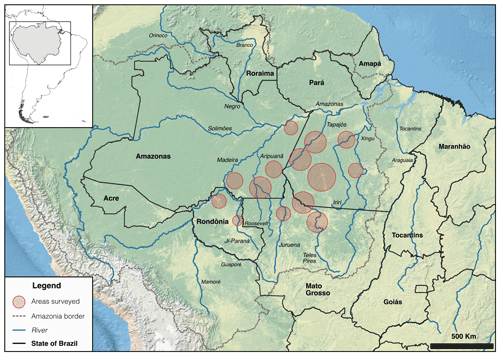
Figure 1Areas surveyed for primate occurrence during 10 field expeditions carried out between 2015 and 2018 in southern Amazonia, the arc of deforestation, Brazil.
Here, we present 192 new records of 22 primate species in 56 localities across the arc of deforestation (Fig. 1). Based on these data, we extend the ranges of Alouatta puruensis, Ateles chamek, and Saimiri collinsi; identify potential hybridization zones between A. puruensis and A. discolor, and between At. chamek and At. marginatus; redefine the range of Plecturocebus moloch; and clarify the ranges of P. baptista and P. hoffmannsi. Primates are valuable as flagship species for conservation (Dietz et al., 1994; Estrada et al., 2017; Chapman et al., 2020) and, as such, investments in research and conservation of the primate species from the arc of deforestation are expected to have a positive cascade effect on the protection of Amazonian biodiversity, ecosystem services, and mitigation of climate change.
From 2015 to 2018, 10 field expeditions were carried out in the arc of deforestation, southern Amazonia, across the states of Amazonas, Mato Grosso, Pará, and Rondônia in Brazil. All large-river interfluves were surveyed for the occurrence of primates as well as the interfluves of second-order rivers in the basins of the Xingu, Tapajós, Aripuanã, Ji-Paraná, Teles Pires, Juruena, Madeira, and Amazonas rivers. The expeditions lasted 21 d on average. A recording of Mico marcai long calls was used for playback in order to enhance the detection of marmosets by Rodrigo Costa-Araújo during active search for primates, which was carried out by foot and by boat along rivers. For each primate observation or vocalization, the species was recorded and the geographical coordinates were taken with a Garmin GPSMap 65s. For vocalization records, the identifications are based on both the long calls, which are genus-specific, and on the locality, for species-level distinctions. For observational records, the species identifications are based on the phenotype of the specimens. The identifications follow the latest review of the taxonomy and distribution of neotropical primates (Mittermeier et al., 2013) and the IUCN Red List (IUCN, 2022). All the records were transformed into decimal degrees using the speciesLink geographical coordinate converter (http://splink.cria.org.br/conversor?criaLANG=en, last access: 15 January 2023) and plotted on a map using QGIS (2023). This research did not involve animal experimentation, and therefore no ethical consent was required.
We obtained 192 new occurrence records of 22 primate species and subspecies of Alouatta, Aotus, Ateles, Cebus, Chiropotes, Lagothrix, Leontocebus, Pithecia, Plecturocebus, Saimiri, and Sapajus (Tables 1 and 2; Supplement). Such records represent 56 localities (Fig. 2), which add to others obtained during the same field expeditions carried out in southern Amazonia between 2015 and 2018 (see Boubli et al., 2019; Costa-Araújo et al., 2019, 2021, 2022b, 2023; Byrne et al., 2021).
Table 1Primate taxa recorded during 10 field expeditions carried out across the arc of deforestation, southern Amazonia, Brazil, between 2015 and 2018. The taxonomy follows Mittermeier et al. (2013) unless otherwise indicated, and the species conservation status follows the IUCN Red List (IUCN, 2022).
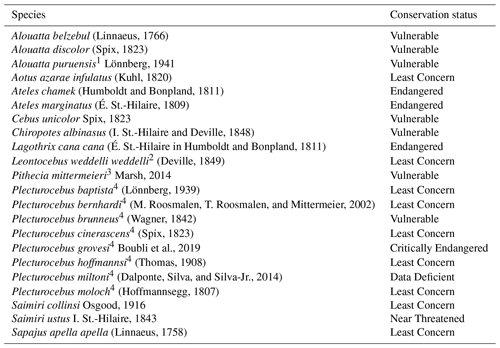
1 Gregorin (2006); 2 Rylands et al. (2016); 3 Marsh (2014); 4 Byrne et al. (2016).
Table 2List of 56 localities in decimal degrees, WGS84 ellipsoid, for the 192 new occurrence records of primates from the arc of deforestation, southern Amazonia, Brazil (see Fig. 2). The localities group occurrence records under the threshold of a 10 km radius.
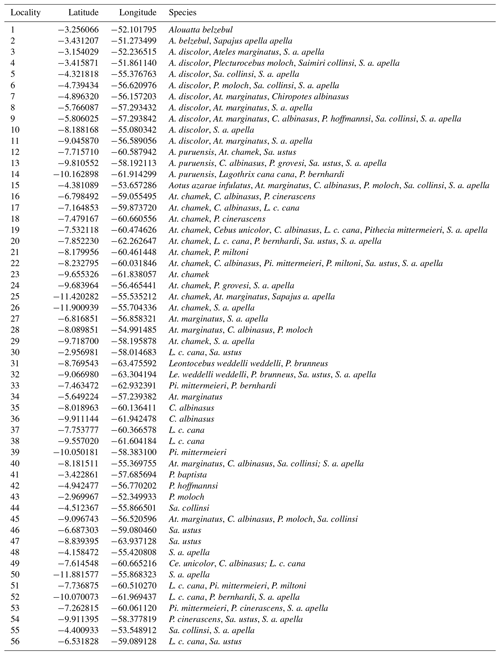

Figure 3Geographic distributions and new records of Alouatta puruensis and Alouatta discolor in southern Amazonia, the arc of deforestation, Brazil, with extension of the geographic distribution of A. puruensis into the right margin of the Juruena River, within 20 km of the range of A. discolor.
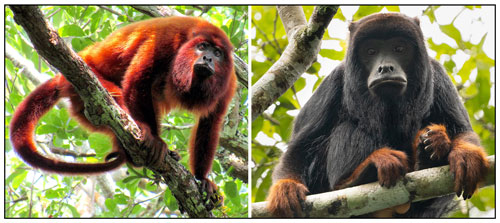
Figure 4Left: adult female of Alouatta puruensis recorded on the right bank of the middle Juruena River, Mato Grosso, Brazil (credit: Rodrigo Costa-Araújo). Right: adult male of Alouatta discolor (credit: Jéssica dos Anjos).
Based on current knowledge of the taxonomy and distribution of neotropical primates (Mittermeier et al., 2013; IUCN, 2022), our records clarify the range and population dynamics of eight species: Alouatta puruensis Lönnberg, 1941, A. discolor (Spix, 1823), Ateles chamek (Humboldt and Bonpland, 1811), At. marginatus (St.-Hilaire, 1809), Plecturocebus moloch (Hoffmannsegg, 1807), P. hoffmannsi (Thomas, 1908), P. baptista (Lönnberg, 1939), and Saimiri collinsi Osgood, 1916. One of our records of Alouatta puruensis is on the right bank of the middle Juruena River, which extends the species range into the Juruena–Teles Pires interfluve, only 20 km from the southwestern limit of the distribution of A. discolor (Fig. 3). Although there is a record of sympatry between these two Alouatta species in the Juruena–Teles Pires interfluve (Paranaíta municipality; Pinto and Setz, 2000), the only species currently considered to occur in this region is A. discolor (Gregorin, 2006). Additionally, we suggest the existence of a natural hybridization zone across the middle Juruena River, with bidirectional dispersal of and introgression in these two Alouatta species, i.e., dispersal of A. puruensis individuals from the left margin and introgression into A. discolor populations in the right margin and vice versa, using the large islands of the middle Juruena River as stepping stones. Howler monkeys can swim across rivers (Gonzalez-Socoloske and Snarr, 2010) and are common on Amazonian fluvial islands (Rabelo et al., 2019). Moreover, introgressive hybridization is relatively common in primates (Cortés-Ortiz et al., 2019a) and is known for howler monkey species with contrasting phenotypes (Cortés-Ortiz et al., 2019b; Mourthé et al., 2019), like A. puruensis and A. discolor (Fig. 4).
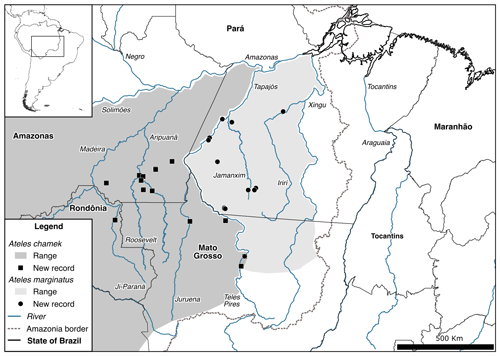
Figure 5Geographic distributions and new records of Ateles chamek and Ateles marginatus in southern Amazonia, the arc of deforestation, Brazil, with extension of the geographic distribution of At. chamek into the right margin of the Teles Pires River, within the range of At. marginatus.
Two of our records of Ateles chamek are on the right margin of the Teles Pires River, within the range of At. marginatus (Fig. 5), as also reported by Lazari et al. (2020). In this region, we observed adult spider monkeys completely black in pelage, lacking the white hairs on the forehead and cheeks that are characteristic of At. marginatus. Therefore, we identified these individuals as At. chamek. Moreover, one of the two records of At. chamek overlaps with a record of At. marginatus. Similarly to the case of A. puruensis and A. discolor in the middle Juruena River, we suggest ongoing, bidirectional dispersal of and gene flow between At. chamek and At. marginatus across the middle Teles Pires River, with fluvial islands as stepping stones. Spider monkeys are also known to swim (Nunes, 2014; Chaves and Stoner, 2010) and can use human-made structures, such as raft cables, to cross rivers (Lazari et al., 2020).
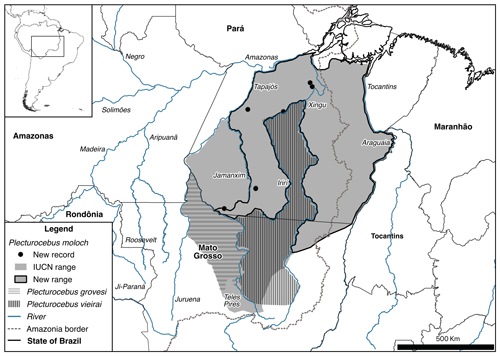
Figure 6New geographic distribution and new records of Plecturocebus moloch together with distributions of Plecturocebus grovesi and Plecturocebus vieirai in southern Amazonia, the arc of deforestation, Brazil.
We propose a new delimitation for the distribution range of P. moloch (Fig. 6) based on our records and on the exclusion of the ranges of P. grovesi and P. vieirai (Gualda-Barrros, Nascimento and Amaral, 2012) (Costa-Araújo et al., 2022b). Plecturocebus grovesi and P. vieirai were recently described for titi monkeys within the range formerly thought to belong to P. moloch (Hershkovitz, 1990; Roosmalen et al., 2002). Nonetheless, it remains necessary to determine the type locality of P. moloch and the validity of two of its synonyms – P. remulus (Thomas, 1908) and P. emiliae (Thomas, 1911) (Lönnberg, 1939; Hershkovitz, 1990) – and to clarify the taxonomy of titis from the Jamanxim–Teles Pires interfluve.

Figure 7New hypothesis for the geographic distribution of Saimiri collinsi in southern Amazonia, arc of deforestation, Brazil.
We found a group of P. baptista within the range of P. hoffmannsi. Our observations reinforce previous findings of Rocha et al. (2019) and Printes et al. (2018). Although Plecturocebus baptista and P. hoffmannsi are easily distinguished by their pelage color, we suggest that their phenotypes might be a clinal variation of a single species as is currently proposed for P. parecis and P. cinerascens (Byrne et al., 2021). This suggestion follows the fact that the taxonomy and distribution of P. baptista and P. hoffmannsi are little studied, they have not been subjected to molecular phylogenetic analyses to date, and there are no physical barriers impeding gene flow between these species. Finally, we recorded Saimiri collinsi on the left bank of the Jamanxim River and on the right bank of the upper Tapajós and lower Teles Pires rivers, extending the species range by approximately 600 km to the west (Fig. 7).
Considering our findings and the new hypotheses raised here, new field expeditions are necessary for obtaining further occurrence records, specimens, and genetic samples for research on the taxonomy, distribution, population dynamics, and evolutionary history of the primate species from the arc of deforestation – especially in areas poorly or never explored to date. Such basic knowledge is also paramount for biodiversity protection because species are the main subjects of awareness-raising and conservation strategies, and the lack of information on their taxonomy and distribution impedes effective conservation measurements (Costa et al., 2005; Rylands and Mittermeier, 2014). The implementation and improvement of conservation strategies envisioned in the National Action Plan for the Conservation of Amazonian Primates (ICMBio, 2017), for example, depend on such basic information.
Additional records, specimens, and samples of A. puruensis and A. discolor in the middle Juruena River and of At. chamek and At. marginatus in the middle Teles Pires River would allow us to refine the taxonomy and the extent of occurrence of these species to confirm the existence of gene flow and to characterize the population dynamics in these hybrid zones. Such field data and materials are also necessary to clarify the taxonomy, distribution, and evolutionary history of P. baptista, P. hoffmannsi, and P. moloch. Given the scarcity of information on and the pace of habitat loss faced by the primates in the arc of deforestation, this should be a priority for research and conservation among platyrrhines.
No datasets were used in this article.
The dataset with 192 new occurrence records of 22 primate species of Alouatta, Aotus, Ateles, Cebus, Chiropotes, Lagothrix, Leontocebus, Pithecia, Plecturocebus, Saimiri, and Sapajus genera can be accessed via the Supplement. The supplement related to this article is available online at: https://doi.org/10.5194/pb-11-1-2024-supplement.
Data collection was led by RCA with collaboration by TH, RRdS, IBdS, LFdS, RMdA, LJ, RBdA, EMSJ, and IM. RCA, IPF, TH, GRC, FRdM, EJHR, LJ, RBdA, and JdSeS-Jr. contributed with resources and logistic support for the field expeditions. RCA assembled the dataset, designed the figures, and wrote the text with contributions from all the authors.
At least one of the (co-)authors is a member of the editorial board of Primate Biology. The peer-review process was guided by an independent editor, and the authors also have no other competing interests to declare.
Publisher's note: Copernicus Publications remains neutral with regard to jurisdictional claims made in the text, published maps, institutional affiliations, or any other geographical representation in this paper. While Copernicus Publications makes every effort to include appropriate place names, the final responsibility lies with the authors.
This article is a result of Rodrigo Costa-Araújo's doctoral thesis carried out within the graduate program in ecology of the National Institute of Amazon Research, Manaus, Brazil, with the invaluable support of Brisa Araújo and a number of people, communities, and friends from southern Amazonia, especially Zagaia, Banha, Catitu, Dona Eunice, Marina and João Lutz, Natal, Seu Luís, Seu Roberto, Ozébio, Reginaldo, Canguru, Pamela Sateré-Mawé and Valdinelis, Nelson and his family, Jóia, Angelisson Tenharin, Nilcelio Djahui, Rosangela Parintintin, friends from TI Cachoeira Seca, Valdir and Jacaré, Fazenda ONF São Nicolau, the Centro Nacional de Pesquisa e Conservação de Primatas Brasileiros (ICMBio/CPB), the Consórcio UHE Teles Pires, Biota Projetos e Consultoria Ambiental, and the teams of the Itaituba, Apuí, and Jaru offices of the Instituto Chico Mendes de Conservação da Biodiversidade, without whom this research would not have been possible. The authors are grateful to Anthony Rylands, Dietmar Zinner, and Eckard Heymann for providing valuable comments on this paper and to Jéssica dos Anjos for the picture of Alouatta discolor.
This research has been supported by the Conselho Nacional de Desenvolvimento Científico e Tecnológico (grant nos. 563348/2010 and 140039/2018-1), the Coordenação de Aperfeiçoamento de Pessoal de Nível Superior (grant nos. 3261/2013, 001, and 88881.512895/2020-01), the Fundação de Amparo à Pesquisa do Estado do Amazonas (grant no. 06200889/2019), the Conservation Leadership Programme (grant no. F02304217), the Margot Marsh Biodiversity Foundation (grant no. 6002856), Idea Wild, and the Alexander von Humboldt-Stiftung (grant no. 88881.512895/2020-01).
This paper was edited by Dietmar Zinner and Jonah Ratsimbazafy and was reviewed by Eckhard W. Heymann and Anthony B. Rylands.
Boubli, J., Melo, F. R., and Rylands, A. B.: Plecturocebus grovesi, The IUCN Red List of Threatened Species, e.T172272064A172272430, https://doi.org/10.2305/IUCN.UK.2020-3.RLTS.T172272064A172272430.en, 2020.
Boubli, J. P., Byrne, H., Silva, M. N. F., Silva-Júnior, J. S., Costa-Araújo, R., Bertuol, F., Gonçalves, J., Melo, F. R., Rylands, A. B., Mittermeier, R. A., Silva, F. E., Nash, S. D., Canale, G., Alencar, R. M., Rossi, R. V., Carneiro, J., Sampaio, I., Farias, I. P., Scheneider, H., and Hrbek, T.: On a new species of titi monkey (Primates: Plecturocebus), from Alta Floresta, southern Amazon, Brazil, Mol. Phylogenet. Evol., 132, 117–137, https://doi.org/10.1016/j.ympev.2018.11.012, 2019.
Boubli, J. P., Canale, G. R., Semedo, T. B. F., Melo, F. R., and Jerusalinsky, L.: Grove's Titi Monkey Plecturocebus grovesi Boubli et al. 2019, in: Primates in Peril: The World's 25 Most Endangered Primates, edited by: Mittermeier, R. A., Reuter, K. E., Rylands, A. B., Jerusalinsky, L., Schwitzer, C., Strier, K. B., Ratsimbazafy, J., and Humle, T., IUCN SSC Primate Specialist Group, International Primatological Society, Re:wild, 8–10, ISBN 978-1-7372851-5-1, 2022.
Byrne, H., Rylands, A. B., Carneiro, J. C., Lynch-Alfaro, J., Bertuol, F., Silva, M. N. F., Messias, M., Groves, C., Mittermeier, R. A., Farias, I., Hrbek, T., Schneider, H., Sampaio, I., and Boubli, J.: Phylogenetic relationships of the New World titi monkeys (Callicebus): first appraisal of taxonomy based on molecular evidence, Front. Zool., 13, 10, https://doi.org/10.1186/s12983-016-0142-4, 2016.
Byrne, H., Costa-Araújo, R., Farias, I. P., Silva, M. N. F., Messias, M., Hrbek, T., and Boubli, J.: Uncertainty regarding species delimitation, geographic distribution, and the evolutionary history of south–central Amazonian titi monkey species (Plecturocebus, Pitheciidae), Int. J. Primatol., https://doi.org/10.1007/s10764-021-00249-9, 2021.
Chapman, C. A., Bicca-Marques, J. C., Dunham, A. E., Fan, P., Fashing, P. J., Gogarten, J. F., Guo, S., Huffman, M. A., Kalbitzer, U., Li, B., Ma, C., Matsuda, I., Omeja, P. A., Sarkar, D., Sengupta, R., Serio-Silva, J. C., Tsuji, Y., and Stenseth, N. C.: Primates can be a rallying symbol to promote tropical forest restoration, Folia Primatol., 91, 669–687, https://doi.org/10.1159/000505951, 2020.
Chaves, Ó. M. and Stoner, K. E.: River crossings by Ateles geoffroyi and Alouatta pigra in southern Mexico: a preliminary report, Rev. Chil. Hist. Nat., 83, 435–442, 2010.
Cortés-Ortiz, L., Roos, C., and Zinner, D.: Introduction to special issue on primate hybridization and hybrid zones, Int. J. Primatol., 40, 1–8, https://doi.org/10.1007/s10764-019-00076-z, 2019a.
Cortés-Ortiz, L., Nidiffer, M. D., Hermida-Lagunes, J., García-Orduña, F., Rangel-Negrín, A., Kitchen, D. M., Bergman, T. J., Dias, P. A. D., and Canales-Espinosa, D.: Reduced introgression of sex chromosome markers in the Mexican howler monkey (Alouatta palliata × A. pigra) hybrid zone, Int. J. Primatol., 40, 114–131, https://doi.org/10.1007/s10764-018-0056-4, 2019b.
Costa, L. P., Leite, Y. L. R., Mendes, S. L., and Ditchfield, A.: Mammal conservation in Brazil, Conserv. Biol., 19, 672–679, https://doi.org/10.1111/j.1523-1739.2005.00666.x, 2005.
Costa-Araújo, R., Melo, F. R., Canale, G. R., Hernaìndez-Rangel, S. M., Messias, M. R., Rossi, R. V., Silva, F. E., Silva M. N. F., Nash, S. D., Boubli, J. P., Farias, I. P., and Hrbek, T.: The Munduruku marmoset: a new monkey species from southern Amazonia, PeerJ, 7, e7019, https://doi.org/10.7717/peerj.7019, 2019.
Costa-Araújo, R., Farias, I., and Hrbek, T.: Mico munduruku, The IUCN Red List of Threatened Species, e.T172269376A172269630, https://doi.org/10.2305/IUCN.UK.2020-2.RLTS.T172269376A172269630.en, 2020.
Costa-Araújo, R., Silva-Jr, J. S., Boubli, J. P., Rossi, R. V., Canale, G. R., Melo, F. R., Bertuol, F., Silva, F. E., Silva, D. A., Nash, S. D., Sampaio, I., Farias, I. P., and Hrbek, T.: An integrative analysis uncovers a new, pseudo-cryptic species of Amazonian marmoset (Primates: Callitrichidae: Mico) from the arc of deforestation, Sci. Rep., 11, 15665, https://doi.org/10.1038/s41598-021-93943-w, 2021.
Costa-Araújo, R., Silva Júnior, J. S., Canale, G. R., Melo, F. R., Boubli, J. P., Farias, I. and Hrbek, T.: Mico schneideri (errata version published in 2022), The IUCN Red List of Threatened Species, e.T210363264A222945240, https://doi.org/10.2305/IUCN.UK.2022-1.RLTS.T210363264A222945240.en, 2022a.
Costa-Araújo, R., Silva, L. G., Melo, F. R., Rossi, R. V., Bottan, J. P., Silva, D. A., Nascimento, F. O., Silva, F. P., Buss, G., Lima-Silva, L. G., Silva, L. F., Fialho, M., Lázari, P. R., Rossato, R. S., Vendramel, R. L., Alencar, R. M., Mendonça, R. F. B., Sampaio, R., Hrbek, T., Silva-Jr., J. S., and Canale, G. R.: Primate conservation in the global deforestation frontier: a study case with the Vieira's titi monkey Plecturocebus vieirai, Oryx, 56, 837–845, https://doi.org/10.1017/S003060532100171X, 2022b.
Costa-Araújo, R., Melo, F. R., Silva-Júnior, J. S., Buss, G., Boubli, J. P., Hrbek, T., and Canale, G. R.: Plecturocebus vieirai (errata version published in 2022), The IUCN Red List of Threatened Species, e.T70330181A222944989, https://doi.org/10.2305/IUCN.UK.2022-1.RLTS.T70330181A222944989.en, 2022c.
Costa-Araújo, R., Bergamasco, G., Roos, C., Farias, I. P., and Hrbek, T.: Notes on the distribution and habitat use of marmosets (Callitrichidae: Mico) from south-central Amazonia, Primate Biol., 10, 7–11, https://doi.org/10.5194/pb-10-7-2023, 2023.
Dietz, J. M., Dietz, L. A., and Nagagata, E. Y.: The effective use of flagship species for conservation of biodiversity: the example of lion tamarins in Brazil, in: Creative Conservation: Interactive Management of Wild and Captive Animals, edited by: Olney, P. J. S., Mace, G. M., and Feistner, A. T. C., Chapman and Hall, London, UK, 32–49, ISBN 0-412-49570-8, 1994.
Estrada, A., Garber, P. A., Rylands, A. B., Roos, C., Fernandez-Duque, E., DiFiore, A., Nekaris, K. A., Nijman, V., Heymann, E. W., Lambert, J. E., Rovero, F., Barelli, C., Setchell, J. M., Gillespie, T. R., Mittermeier, R. A., Arregoitia, L. V., Guinea, M., Gouveia, S., Dobrovolski, R., Shanee, S., Shanee, N., Boyle, S. A., Fuentes, A., MacKinnon, K. C., Amato, K. R., Meyer, A. L., Wich, S., Sussman, R. W., Pan, R., Kone, I., and Li, B.: Impending extinction crisis of the world's primates: why primates matter, Sci. Adv., 3, e1600946, https://doi.org/10.1126/sciadv.1600946, 2017.
FAO: Global forest resources assessment 2015, 2nd edn., Food and Agriculture Organization of the United Nations, https://www.fao.org/forest-resources-assessment/e (last access: 8 September 2020), 2016.
Fearnside, P. M.: Deforestation in Brazilian Amazonia, in: Oxford bibliographies in environmental science, edited by: Wohl, E., Oxford University Press, New York, USA, https://doi.org/10.1093/acrefore/9780199389414.013.102, 2017.
Fearnside, P. M., Righi, C. A., Graça, P. M. L. A., Keizer, E. W. H., Cerri, C. C., Nogueira, E. M., and Barbosa, R. I.: Biomass and greenhouse-gas emissions from land-use change in Brazil's Amazonian “arc of deforestation”: the states of Mato Grosso and Rondônia, Forest Ecol. Manag., 258, 1968–1978, https://doi.org/10.1016/j.foreco.2009.07.042, 2009.
Fialho, M. S., Jerusalinsky, L., Moura, E. F., Ravetta, A. L., Laroque, P. O., Queiroz, H. L., Boubli, J. P., and Lynch-Alfaro, J. W.: Cebus kaapori (amended version of 2020 assessment), The IUCN Red List of Threatened Species, e.T40019A191704766, https://doi.org/10.2305/IUCN.UK.2021-1.RLTS.T40019A191704766.en, 2021.
Gonzalez-Socoloske, D. and Snarr, K. A.: An incident of swimming in a large river by a mantled howling monkey (Alouatta palliata) on the north coast of Honduras, Neotrop. Primates, 17, 28–31, https://doi.org/10.1896/044.017.0102, 2010.
Gregorin, R.: Taxonomia e variação geográfica das espécies do gênero Alouatta Lacépède (Primaes, Atelidae) no Brasil, Rev. Bras. Zool., 23, 64–144, https://doi.org/10.1590/S0101-81752006000100005, 2006.
Hershkovitz, P.: Titis, New World monkeys of the genus Callicebus (Cebidae, Platyrrhini): a preliminary taxonomic review, Fieldiana Zool., 55, 1–109, 1990.
ICMBio: Plano de Ação Nacional para a Conservação dos Primatas Amazônicos (Portaria 792 de 01/12/2017), Diário Oficial da União, 232, 24, 2017.
IUCN: The IUCN Red List of Threatened Species, version 2022-2, https://www.iucnredlist.org (last access: 10 March 2023), 2022.
Kirby, K. R., Laurance, W. F., Albernaz, A. K. M., Schroth, G., Fearnside, P. M., Bergen, S., Venticinque, E., and Costa, C.: The future of deforestation in the Brazilian Amazon, Futures, 38, 432–453, https://doi.org/10.1016/j.futures.2005.07.011, 2006.
Laurance, W. F., Albernaz, A. K. M., Schroth, G., Fearnside, P. M., Bergen, S., Venticinque, E. M., and Costa, C.: Predictors of deforestation in the Brazilian Amazon, J. Biogeogr., 29, 737–748, https://doi.org/10.1046/j.1365-2699.2002.00721.x, 2002.
Lazari, P. R., Oliveira, A. T. M., Sandmann, P. H. D., Miguel, B. V., Fontes, M. C., Filho, N. R. A., Guirau, G. V. F., Henicka, T. S., Silva, L. F., Canale, G. R., and São-Bernardo, C. S.: Parâmetros demográficos de populações de duas espécies ameaçadas de macacos-aranha, Ateles chamek e Ateles marginatus, no ecótono Cerrado–Amazônia, Neotrop. Primates, 26, 97–103, https://doi.org/10.62015/np.2020.v26.50, 2020.
Lönnberg, E.: Notes on some members of the genus Callicebus, Ark. Zool., 31, 1–19, 1939.
Marsh, L. K.: A taxonomic revision of Pithecia Desmarest, 1804, Neotrop. Primates, 21, 1–165, https://doi.org/10.1896/044.021.0101, 2014.
Mittermeier, R. A., Rylands, A. B., and Wilson, D. E.: Handbook of the mammals of the world, vol. 3: Primates, Lynx, Barcelona, Spain, ISBN 978-84-96553-89-7, 2013.
Mourthé, Í., Trindade, R., Aguiar, L., Trigo, T., Bicca-Marques, J. C., and Bonatto, S.: Hybridization between Neotropical primates with contrasting sexual dichromatism, Int. J. Primatol., 40, 99–113, https://doi.org/10.1007/s10764-017-0011-9, 2019.
Nunes, A. V.: Report of a black spider monkey (Ateles chamek) swimming in a large river in central-western Brazil, Neotrop. Primates, 21, 204–206, 2014.
Pinto, L. P. and Setz, E. Z. F.: Sympatry and new locality for Alouatta belzebul discolor and Alouatta seniculus in the southern Amazon, Neotrop. Primates, 8, 150–151, 2000.
Port-Carvalho, M., Muniz, C. C., Fialho, M. S., Alonso, A. C., Jerusalinsky, L., and Veiga, L. M.: Chiropotes satanas (amended version of 2020 assessment), The IUCN Red List of Threatened Species, e.T39956A191704509, https://doi.org/10.2305/IUCN.UK.2021-1.RLTS.T39956A191704509.en, 2021.
Printes, R. C., Buss, G., Azevedo, R. B., Ravetta, A. L., and Silva, G. N.: Update on the geographic distributions of two titi monkeys, Plecturocebus hoffmannsi (Thomas, 1908) and P. baptista (Lönnberg, 1939), in two protected areas in the Brazilian Amazon, Primate Conserv., 32, 81–88, 2018.
QGIS: QGIS Geographic Information System, QGIS Association, http://www.qgis.org (last access: 15 January 2023), 2023.
Rabelo, R. M., Aragón, S., and Bicca-Marques, J. C.: Prey abundance drives habitat occupancy by jaguars in Amazonian floodplain river islands, Acta Oecol., 97, 28–33, https://doi.org/10.1016/j.actao.2019.04.004, 2019.
Ravetta, A. L., Buss, G., and Mittermeier, R. A.: Ateles marginatus (amended version of 2019 assessment), The IUCN Red List of Threatened Species, e.T2282A191689524, https://doi.org/10.2305/IUCN.UK.2021-1.RLTS.T2282A191689524.en, 2021.
Rocha, A., Barnett, A. P. A., and Spironello, W. R.: Extension of the geographic distribution of Plecturocebus baptista (Pitheciidae, Primates) and a possible hybrid zone with Plecturocebus hoffmannsi: evolutionary and conservation implications, Acta Amazon., 49, 330–333, https://doi.org/10.1590/1809-4392201803411, 2019.
Roosmalen, M. G. M., Roosmalen, T., and Mittermeier, R. A.: A taxonomic review of the titi monkeys, genus Callicebus Thomas, 1903, with the description of two new species, Callicebus bernhardi and Callicebus stephennashi, from Brazilian Amazonia, Neotrop. Primates, 10, Suppl., 1–52, https://doi.org/10.62015/np.2002.v10.503, 2002.
Rylands, A. B. and Mittermeier, R. A.: Primate taxonomy: species and conservation, Evol. Anthropol., 23, 8–10, https://doi.org/10.1002/evan.21387, 2014.
Rylands, A. B., Heymann, E. W., Lynch-Alfaro, J., Buckner, J. C., Roos, C., Matauschek, C., Boubli, J. P., Sampaio, R., and Mittermeier, R. A.: Taxonomic review of the New World tamarins (Primates: Callitrichidae), Z. J. Linn. Soc.-Lond., 177, 1003–1028, https://doi.org/10.1111/zoj.12386, 2016.
Silva, F. E., Bizri, H. R., Gonçalves, J. R., Lemos, L. P., Costa-Araújo, R., Lima, I. J., Santos, A. T., Santana, M. I., Franco, C. L. B., and Boubli, J. P.: The Roosevelt–Rondon expedition marmoset Mico marcai: unveiling the conservation status of a data deficient species, Oryx, 54, 539–45, https://doi.org/10.1017/S0030605318000303, 2020.
Silva Junior, C. A., Costa, G. M., Rossi, F. S., Vale, J. C. E., Lima, R. B., Lima, M., Oliveira-Júnior, J. F., Teodoro, P. E., and Santos, R. C.: Remote sensing for updating the boundaries between the Brazilian Cerrado-Amazonia biomes, Environ. Sci. Pol., 101, 383–392, https://doi.org/10.1016/j.envsci.2019.04.006, 2019.
Thomas, O.: Four new Amazonian monkeys, Ann. Mag. Nat. Hist., 2, 88–91, 1908.
Thomas, O.: Three new mammals from the lower Amazons, Ann. Mag. Nat. Hist., 7, 606–608, 1911.




